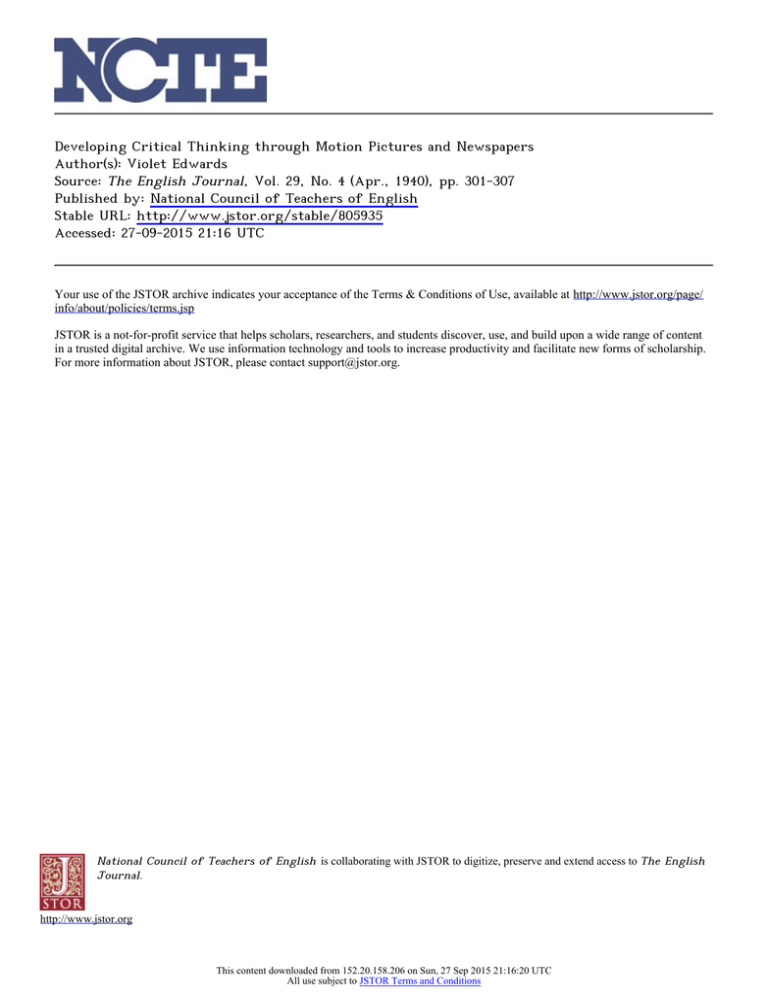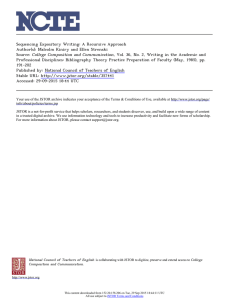Developing Critical Thinking through Motion Pictures and Newspapers Author(s): Violet Edwards Source:
advertisement

Developing Critical Thinking through Motion Pictures and Newspapers Author(s): Violet Edwards Source: The English Journal, Vol. 29, No. 4 (Apr., 1940), pp. 301-307 Published by: National Council of Teachers of English Stable URL: http://www.jstor.org/stable/805935 Accessed: 27-09-2015 21:16 UTC Your use of the JSTOR archive indicates your acceptance of the Terms & Conditions of Use, available at http://www.jstor.org/page/ info/about/policies/terms.jsp JSTOR is a not-for-profit service that helps scholars, researchers, and students discover, use, and build upon a wide range of content in a trusted digital archive. We use information technology and tools to increase productivity and facilitate new forms of scholarship. For more information about JSTOR, please contact support@jstor.org. National Council of Teachers of English is collaborating with JSTOR to digitize, preserve and extend access to The English Journal. http://www.jstor.org This content downloaded from 152.20.158.206 on Sun, 27 Sep 2015 21:16:20 UTC All use subject to JSTOR Terms and Conditions DEVELOPING CRITICAL THINKING THROUGH MOTION PICTURES AND NEWSPAPERS VIOLET EDWARDSI This afternoon I want to describe, at least in part, specifically what is being done this year in a number of English classes to further the developmentof critical thinking through use of the motion picture and the newspaper. The classesI have in mind are "run of the mill" public school English classes; they exceed fifty in number; they range from sixth grade throughthe junior and senior high schools in such diverselocales and communitiesas Manhasset,Long Island; Elkhart,Indiana; Cleveland,Ohio;New York City; Hackensack, New Jersey; Glendale, California;and Denver, Colorado. A number of the teachers of these classes worked together last summerfor six weeks in a first and experimentalpropaganda-analysis workshopcourse. This coursewas conductedby ProfessorClyde R. Miller, who was assisted by the staff of the Institute for Propaganda Analysis and by several of the Institute's co-operatingteachers; it was given at Teachers College, ColumbiaUniversity. In its small registrationof less than thirty personsthere were represented not only many geographical,sectional, and community differences but also great differencesof educational philosophy and practice. The groupwas divided almost equally into the subject-matterfields of English and of the social studies. I hasten to point out that these very factors stimulated and enrichedour course--our group-discussion and work conferences. Indeed, our attention was focused upon re-examinationof the learningprocessitself. Not only did the teachers of English form a workinggroupof their own, but they helped to organizea curriculumcommittee for the expresspurposeof appraising varioususes of the newspaper,the motion picture, and the radio in the English classroom. They recognizeda very real need to examine critically the content of their English and social studies I Educational Director of the Institute for Propaganda Analysis, New York City. This paper was read at the New York convention of the National Council of Teachers of English, November 24, 1939. 3o0 This content downloaded from 152.20.158.206 on Sun, 27 Sep 2015 21:16:20 UTC All use subject to JSTOR Terms and Conditions 302 THE ENGLISH JOURNAL coursesin the light of today's knowledgeof (i) basic personalneeds of young people as individualsinteractingwith their social-psychological environment, especially as this environment is shaped by newspapersand by movies, and (2) contemporarysociety and its possible trends. I have taken several valuable minutes in which to give a hastyvery far from complete-frame of referencefor some of the techniques, some of the methods and generalizationsdeveloped by this group of teachersin their use of movies and newspapersto increase individualand groupability to think critically. I wish some of these teacherswere here today to give you graphicpictures of their classrooms at work. Sincethis discussionis concernedprimarilywith "settingthe stage" for developing critical thinking through practical and intelligent uses of motion pictures and newspapers,it is essential to define the term lest it becomeone more glitteringgenerality. I am using "critical thinking," as an expressionof the scientificmethod, to mean in the words of Dr. S. P. McCutchen: i. 2. 3. 4. 5. 6. One who faces the social situation intelligently: Defines or describes the problem correctly, Looks at the feasible courses of action, Collects and interprets the pertinent information, Reaches a tentative decision in the light of the evidence, Acts in accordance with the decision, and Reconstructs his patterns on the basis of his experience. Such a processis necessaryto the maintenanceand development of our democraticsociety. In this processpropagandaanalysis, the building of effective techniquesfor thinking critically, is a means to an end-the participationby the commonman in the solutionof the majorproblemsof his own life and of our Americansociety. (A word of caution: Too frequentlyeducatorshave grownto considersemantics, critical thinking, or problem-solvingas ends in themselves.) You will, I believe, want to keep in mind both the objectives and the process of critical thinking as I give some of the generalizations and conclusionswhich grew out of our summer conferences. Chief among these are: i. It is not enough merely to have in mind in our work with motion pictures and newspapersthe goal of "developing critical- This content downloaded from 152.20.158.206 on Sun, 27 Sep 2015 21:16:20 UTC All use subject to JSTOR Terms and Conditions DEVELOPINGCRITICALTHINKING 303 mindedness"in general terms. This goal must be made specific in terms of (a) our pupils' interests, needs, and values; (b) our pupils' age and maturity levels; and (c) our pupils' home and community environmentsand demands. 2. To insureour being guidedby the maturity levels and interests of our pupils-to preventas far as possibleteacher-propelledstudy of movies and newspapers-let us painstakinglyencouragepupil planning and discussionof the project and its objectives. In other words, we are recognizingin practice that 3. Childrenand young people must not be forced,or stirredemotionally, to face problems about which they can do nothing. Their use of movies and newspapers,then, will not superimposeproblems upon them which are not legitimately their own problems. In our experimentalwork we have found that many of the concepts from the movies are too adult for most ten-year-oldchildrenand, for that matter, for many juniorhigh schoolpupils. (Forexample,race problems do not usually become personal until adolescence;Negro and white childrenplay together until they are eleven or twelve.) When children take up such mature problems the outcomes are frequently far differentfrom the ones we teachersseek. For example,a study of war-in motion pictures-may set up in the young child a fear that his fatherwill be killed in a war. The study of family living based on movie material may, in childrennot mature enough for such study, set up a fear that parents will get a divorce. In any case these are problemswhich childrencannot solve; they are adult problems. Young adults in senior high schools are, of course, and rightfully, concerning themselves with many aspects of such problems, particularly with the threateningnews from Europe. Recognizingthat all our channelsof communicationare organizedto give the American public last-minute news of the war, these boys and girls and their teachers,followingthe day-by-day accountsof a seriesof crises, have been able to study newspapers,newsreels, and radio. Many groups, having begun their study with the Munich crisis, have studied recent news from Europe as the latest of a series of crises; many newspaper,magazine, and movie reports and interpretations have been available for their study. They report that the motion picturesConfessionsof a Nazi Spy and Juarezhave been of particular value. They have searchedfor the "story back of the news." They This content downloaded from 152.20.158.206 on Sun, 27 Sep 2015 21:16:20 UTC All use subject to JSTOR Terms and Conditions 304 THE ENGLISH JOURNAL know that news must come over a cable or over the air through facilities subject to the censor's control; they know that reporters and editorshandle the news with all the human frailties,biases, and peculiaritieswhich an army of correspondentshave pointed out in such volumes as PersonalHistory and Behind the News. Many of these groupsare accompanyingtheir study of European war news with an examination of one or more domestic conflicts which have gained consistent space in the press, for the purposeof comparingand contrastingthe handlingof the two situationsby the newspaper, the newsreel, the radio. Reports from co-operating teachers and students workingin this field reveal that evaluation of outcomes of their study is easierwhen they state their objectives in terms of changesin student behavior. For example: He (the pupil) knows when the editor has placed a story on page 2. He reads the news columns and then sees if the headline is misleading. He can explainwhat stereotypesare appealedto in a movie. He is willing to work for and with others while thinking and deciding for himself. Parenthetically, I wish to point out that many of the teachers of these groups keep a log or diary account of group and class discussions. 4. The study of the newspaper (and, to a slightly lesser extent, the motion picture) is not a specific part of information or skill which belongs to any particularlevel. It is something which permeates the life of childrenas well as of adults. All of us, from the kindergartenstage throughthe college level, need to become articulate about our experiences. Presumablythat is why we have English courses. 5. Young people of juniorhigh school age, our experimentalwork shows, can think critically about many things related to the movies and at the same time retainan enjoymentof currentfilms that is the right of all persons. They can, for example, learn to select motion pictureson the basis of more considerationof values than merely the presenceof a favorite "star"in the cast. They can examinecritically the differencesbetween advertisements, advertising "story copy," and genuine news stories about films and film people. Moreover, since many have read the books-books and stories ranging from Heidi, Snow White, and The Wizardof Oz to Drums along the Mo- This content downloaded from 152.20.158.206 on Sun, 27 Sep 2015 21:16:20 UTC All use subject to JSTOR Terms and Conditions DEVELOPINGCRITICALTHINKING 305 hawkand Mill on theFloss-they can learn to ask: Were the stories like the movies? Where do differencesoccur? Why were changes made? They can effectively carry on study of light, color, sound, and dramatic technique, thus increasingtheir ability to appreciate motion pictures. With wise guidancethey may also ask: What was the purpose of this particularpicture (it may be Zola or Abraham Lincolnor A PresidentVanishes). At the present time a seniorhigh school group is doing a most interesting experimentalstudy in the classificationof movie "stills" accordingto certain common propaganda devices such as name-calling,transfer,plain folks, and glittering generalities. They procuredthe "stills"from their local motionpicture theater whose managerwas eager to supply them. Let us pause here to emphasizethat especially in the vital fields of moderncommunicationEnglish class work shouldbe built around the interests of the boys and girls themselves in movies or in newspapers or in radio. Rememberour pupils themselves can best indicate where their real interests lie. If Tarzan movie serialsor Walter Winchell'scolumn or the "funnies"were the fields of their greatest interest, then study of these shouldbe the basis of work in beginning critical study for the class. This study will lead to a wider range of experiences. Many of our last summer'sgroup have found it worth while to read a great deal about child and adolescentpsychologywhile listening to the accountsof the movie likes and dislikeswhich their young people give. Childhoodand youth have their own values, and probably too frequently we have failed to respect their personalitiesby imposing our own ideas upon them at too early an age. We respect men and women of all classes, races, and creeds in our democratic society. Let us add to this, respectfor young people as young people. In our study of motion pictures and newspaperslet us start with the child or the young person in his world of fantasy which he enjoys so much and understandwhat he is thinking, feeling, and enjoying and then act as a guide, but permit him to travel his own road to maturity. However, it is well to ask: Do we know what are the honest interests of our boys and girls? Possibly even if we think we do, we should devote considerabletime to listening to their free discussionsof their This content downloaded from 152.20.158.206 on Sun, 27 Sep 2015 21:16:20 UTC All use subject to JSTOR Terms and Conditions 306 THE ENGLISH JOURNAL special interests, to encouragingthem to express in writing their genuine interests in the movies and in the newspapers.Then we can work more effectivelyin and through these interests. Methods of free group discussion, including the Town Hall technique, contribute to the functionalstudy of movies and newspapers;certainly they have their place in the English class. And so, too, have the informal diary or letter or column or scenario-all formsof organized expression. Good old-fashioned practice in writing, in careful organization of one's thoughts, is in itself a road to clearerthinking. The teacher's basic concern, then, in the use of motion pictures and newspapersfor developingcritical thinking is in the continuous development in each child at his rate of growth, of the ability to organize his experiencesand so build generalizationsout of those experience-all to the end that each child is better able to meet the next experience. And in this task our first axiom must be: We are not teaching English; nor are we teaching critical thinking; we are teaching young people. We are teaching fifteen-year-old Mary, whose head is filled with the "cardboardlovers" of the screen;we are teaching William, whose Horatio Alger pattern of success throughacquiringpersonalwealth is taken fromHollywood. I know a teacher who was wise enough to begin with William's Horatio Alger dream;it was not long before Williamwas readingand discussing Lewis Mumford'sThe Cultureof Cities. Thus, for him and for his schoolmatesnew vistas for collective achievementin rebuilding his home town, for providinggreater facilities for recreation,better homes, and the like, have opened. This teacher did not impose her own standardsof what is "good" or "bad" in the movies upon her young people. Like her, we have a far more useful and significanttask: the finding of vital things in ourpupils'lives with whichwe can work,linking up these with the requiredsubject matter of our so-calledtraditional or progressivecourses. For this task we can find no more practical and pertinent vehicles than the newspaperand the motion picture, permeatingas they do the lives of all of us. If we concernourselveswith this task we may be sure that we will not have a classroomof youngsterswho saw in Zola not a powerful story of the rights of free speech but pro-Jewishpropaganda.Nor This content downloaded from 152.20.158.206 on Sun, 27 Sep 2015 21:16:20 UTC All use subject to JSTOR Terms and Conditions READING MADE FASHIONABLE 307 will we develop in girls and boys a spuriouskind of cynicism which says in effect, "You can't believe anything you read in the papers; it's all propaganda." READING MADE FASHIONABLE ROWENA C. DRAKE" In our continuoussearchfor new ways of creatinginterest in books and extensive voluntary readingthe biennialbook exhibit has been one of our happiest discoveries. As an ever new and evolving form of activity it seems to renew the interest of the entire high school as well as to arouse the enthusiasm of each class that undertakes its management. It has led a sort of Topsy-like growth from the first informal exhibit, managed by a Junior English class, to the last somewhat elaborate and extensive achievement of an enthusiastic Freshmangroup. It was initiated by a group of Juniors inspired by an exhibit of books for small childrenwhich was sponsoredby the public library and a collaboratingbookshop,for the purposeof guiding bewildered mothers and aunts in the wise selection of books for Christmas. When I tentatively suggested a rival book show for the high school, one of the Juniors remarked,"I'll say our relatives certainly need 'guidance' in selecting our books for Christmas. What do you suppose my aunt gave me last Christmas?A perfectly bee-utifulvolume of Lamb's Talesfrom Shakespeare." Louise is one of several in her class who have voluntarily read nearly all the plays of Shakespearethat are ever read by anyone except an English teacher and, having taken part in two Shakespeareanproductions,loves to quote the lines like a veteran actor of the old school. Louise's remark precipitated a somewhat scornful discussion of literary white elephantspresentedfor past Christmases,which I interruptedwith the question: "Not to be inquisitive,but just how do you select new books for yourself?" ' Teacher of English in the Sunset Hill School for Girls, Kansas City, Mo. This content downloaded from 152.20.158.206 on Sun, 27 Sep 2015 21:16:20 UTC All use subject to JSTOR Terms and Conditions




